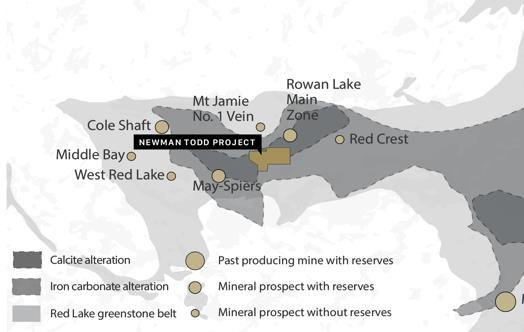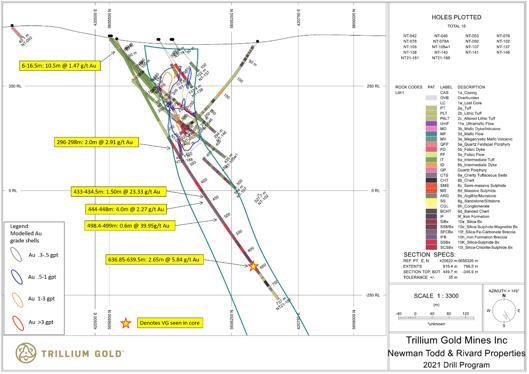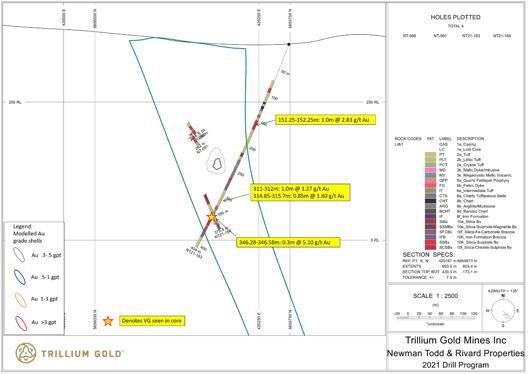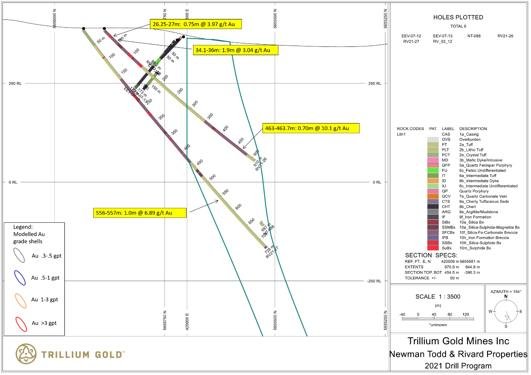- Assays for the next six holes at the NT Zone returned values up to 66.40 g/t Au over 1.0 metre
- Other significant intercepts include 39.95 g/t Au over 0.6 metres, 5.84 g/t Au over 2.65 metres and 10.1 g/t Au over 0.7 metres
- Confirmation and extension of the NT Zone an additional 150 metres to the southwest
- A series of fan holes within the NT structure nearing completion, testing model to target higher grade shoots
These six drill holes (Figure 1) span the southern half of the NT Zone, testing the gap in historical drilling under Abate Lake to further testing its southwestern extents. These six holes (NT21-181 to 184 and RV21-26 & 27 totalling 3,436 metres) have now received complete and verified assays bringing total reported drilling at Newman Todd in 2020 and 2021 to 10,505 metres in 24 drill holes. More drilling has been completed and will be released as assays are received and verified.
“These recent drilling results have only begun to unlock the high grade potential of gold mineralization at Newman Todd, particularly in the gap underlying Abate Lake which was never previously drilled as well as deeper along the footwall contact and extending to the southwest. Further drilling in the southwest is revealing a structural corridor where the NT Zone has been dislocated but still present. The significant intercepts encountered here all indicate that the potential for infill drilling and expanding the mineralization along strike and at depth continues to be promising and that high grade gold permeates the entire NT structure. We have also seen the NT Zone in recently exposed outcrops in this same area,” stated Bill Paterson, Trillium Gold’s Vice President of Exploration.
Russell Starr, CEO of Trillium Gold commented, “We have now received the bulk of the assays that were back-logged at the lab since early January and are on the way to delivering a much more robust exploration model that will positively impact the importance of the NT Zone as the next open-pittable deposit in Red Lake with potential for more high grade mineralization at depth. We are consistently encountering significant high grade gold results, often accompanied by visible gold at surface, which is validating our understanding of the structural and veining controls over the high grade mineralization at the NT Zone.”
Hole NT21-181 (Figure 3) was targeted to begin filling in the large wedge-shaped gap in historical drilling under Abate Lake in the vicinity of the Hinge Zone Fault. This hole was designed to test the NT Zone down to 650m depth. The hole intersected the NT Zone from 264.5m depth, encountering several mineralized breccia zones to 640.2m depth. VG was seen in a 5 mm quartz vein in the 638.7-639m interval, a new intercept likely associated with the lower mineralization zones intersected previously northeast and southwest of this hole, thereby likely expanding the known resource at depth in this area. The significant intercepts of 1.5m @ 23.33 g/t Au from 433m, 0.6m @ 39.95 g/t Au from 498.4m and 2.65m @ 5.84 g/t Au from 636.85m indicate the upside in filling in the drilling gap and expanding on the mineralization downward, and that high grades are still present.
NT21-182 (Figure 4) was drilled in the opposite direction to the majority of the drilling, following up to the northeast on the VG intersection in NT20-175 near the collar of the hole. The drill hole collared in the same limestone / carbonate breccia unit as in NT20‑175 hole 60m southwest along strike. While no similar silicified unit was logged in NT21-182, there were still several mineralized intervals in this hole up to 0.43m @ 4.65 g/t Au from 175.9m.
NT21-183 (Figure 5) was drilled in similar fashion to NT21-182 except approximately 60m to the southwest of NT20-175. Deep overburden was encountered in this hole (70.9m) with the target breccia zone encountered from 86.36 to 95.17 metres depth. Weak gold mineralization was encountered here. Further hanging wall units were intersected, including weak silica-sulphide breccia zones to the upper NT Zone contact at 264.6m. NT Zone silica-carbonate breccia was encountered to 288.6m followed by several patchy zones of silica-sulphide breccia to 383.8m where the footwall contact of the NT Zone was crossed. VG was noted at 344.5-346.6m in two 5mm quartz veins and associated with fine acicular arsenopyrite and assayed 0.3m @ 5.1 g/t from 346.28m. The lower assay for this interval can be explained by the typically nuggetty nature in Red Lake mineralization.
NT21-184 (Figure 6) was a steeply-dipping hole designed to expand on mineralization in the southwest NT Zone. Significant intercepts from this hole include 1m @ 66.4 g/t Au from 169m and 0.75m @ 6.21 g/t Au from 406.15m despite the absence of VG associated with the former. The hole collared in the north band of the NT Zone in this area drilling 18.5m thereof. After an interval of the usual felsic tuff footwall rocks, the hole again encountered mainly NT Zone breccias, with minor intervening units of massive to sheared felsic tuffs, from 106.15m to 645.3m. More felsic tuffs were encountered to 698m and the hole was discontinued for a later date in that the hanging wall contact was never reached.
RV21-26 (Figure 7) was collared on the Rivard property and targeted the projected southwest extension of the north band of the NT Zone. Significant mineralization was noted sporadically over much of the hole length with a best assay of 0.7m @ 10.1 g/t Au from 463m. The hole collared in the NT Zone and intersected weak sulphide mineralized silica-carbonate breccia and stromatolite banded sections in the first 50m of the hole. This was followed by moderately mineralized silica-sulphide-magnetic breccia bands and silica-sulphide breccia bands. The hole ended in felsic tuff and based on the NT Zone intersection at the collar, a second hole on section, RV21-27, was planned.
RV21-27 (Figure 7) is in follow up to hole RV21-26, which it collared behind and drilled below. The hole started in felsic tuff, and entered the north band of the NT Zone at 160.48m and remained therein until 435.4m, intersecting multiple sections of weak to moderately mineralized silica-sulphide-magnetite breccia. The south band of the NT Zone was intersected at 459.3m and the hole stayed in the Zone until 481.24m. From there to 723.8m the hole intersected felsic tuffs with a best assay of 1m @ 6.89 g/t Au from 556m. From 723.8m to the end of the hole at 728.0m, the hole intersected quartz veining/silica breccia as well as cherty metasediments that may be the hanging wall units of the NT Zone. The hole stopped in mineralization and it is planned to be deepened in the future to test further at depth.
These three southerly holes encountered non-traditional stratigraphy (but the same rock types) showing that the NT Zone in this area is more complex than previously understood. It has bifurcated and a prominent east-west structural corridor is evident in magnetic surveys where the
NT Zone has been de-magnetized. Our drilling has confirmed the presence of the mineralized breccias but more drilling is required to further model the structural complexity of this area.
New significant assay composite results are compiled in Table 1 below.
Table 1: Newman Todd significant assay composite results.
All widths are down-core lengths. Not enough information has been collected to determine true widths. Bolded intervals contain visible gold.
Table 2: Table of drillhole location details for holes reported in the current press release.
Prior drilling on the NT Zone from 2013 and earlier had mostly focused on testing the Zone by targeting the footwall with drilling toward the southeast, now known to be sub-parallel to gold mineralized veining and structures, potentially missing high-grade intersections or undercutting much of the targeted zone. Newman Todd is a highly prospective target with 41% of the 165 historic drill holes having intervals of greater than 20 g/t gold over various lengths. In addition, nearly all drilling has been conducted to depths of less than 400 metres.
The Red Lake Camp is famously known for high grade gold mineralization at depth, with Evolution Mining’s Red Lake Gold Mine currently reaching depths of several thousand feet. Trillium will continue to test various drill orientations in order to develop a comprehensive understanding of the mineralization and structural controls and test the depth potential of the Newman Todd Zone. Figure 2 below shows the location of the Newman Todd Project as well as its relative location to the nearby past producing mines within the Red Lake Camp.
All drilling was supervised by Paul Barc, PGeo. The drilling was conducted by Rodren Drilling Ltd., of West St. Paul, Manitoba. Drill core was logged and sampled in a secure core facility on site. Core samples from the program were cut in half, using a diamond cutting saw, and half cores were sent for analysis to the SGS Laboratory in Red Lake, ON, and Burnaby, BC and Activation Laboratories Ltd. in Dryden and Thunder Bay, ON, all accredited mineral analysis laboratories. All samples were analysed for gold using standard Fire Assay-AA techniques. Samples returning over 10.0 g/t gold were analyzed utilizing standard Fire Assay-Gravimetric methods. Selected samples with results greater than one ounce per ton gold were also analyzed with a standard 1 kg metallic screen fire assay. Certified gold reference standards, blanks and duplicates are routinely inserted into the sample stream, as part of Trillium Gold’s quality control/quality assurance program (QAQC) to monitor accuracy and precision. No QAQC issues were noted with the results reported herein. All drill intercepts reported are down-hole core lengths, which does not necessarily represent true widths.
The technical information presented in this news release has been reviewed and approved by William Paterson QP, PGeo, VP of Exploration of Trillium Gold Mines., as defined by NI 43-101.
For further information, please contact Donna Yoshimatsu, VP Corporate Development and Investor Relations at dyoshimatsu@trilliumgold.com, (416) 722-2456, or info@trilliumgold.com, 604-688-9588.
Visit our website at www.trilliumgold.com.
On behalf of the Board of Directors,
Trillium Gold Mines Inc.
“Russell Starr”
Russell Starr
President, CEO and Director
About Trillium Gold Mines Inc.
Trillium Gold Mines Inc. is a growth focused company engaged in the business of acquisition, exploration and development of mineral properties located in the Red Lake Mining District of Northern Ontario. The Company recently extended its holdings in the Confederation Lake and Birch-Uchi greenstone belts, as well as in highly prospective properties in Larder Lake, Ontario and the Matagami and Chibougamou areas of Quebec.
Neither TSX Venture Exchange nor its Regulation Services Provider (as that term is defined in the policies of the TSX Venture Exchange) accepts responsibility for the adequacy or accuracy of this release.
This news release contains forward-looking information, which involves known and unknown risks, uncertainties and other factors that may cause actual events to differ materially from current expectation. Readers are cautioned not to place undue reliance on these forward-looking statements, which speak only as of the date of this press release. The Company disclaims any intention or obligation, except to the extent required by law, to update or revise any forward-looking statements, whether as a result of new information, future events or otherwise.







